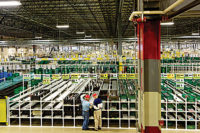Ralph Braun showed the world his many abilities over many years before dying in 2013. Born in 1940 and diagnosed with muscular dystrophy at 6 years old, Braun created a motorized wagon less than a decade later to help him get around. In 1962, he built a motorized scooter, which he called the Tri-Wheeler, and rode it to and from his day job as a quality control manager for a nearby manufacturer.
Braun then began building and selling the scooter out of his parents’ garage at night under the name Save-A-Step (SAS) Manufacturing Co. A few years later, Braun equipped an old Post Office Jeep with a hydraulic tailgate lift and homemade hand controls so he could travel to work more easily.
In 1970, Braun retrofitted Dodge’s first full-sized, front engine van with his Lift-A-Way wheelchair lift. Word spread about this new invention, leading to increased demand and the need for Braun to make running his lift-manufacturing business a full-time job. SAS became The Braun Corp. in 1970 and BraunAbility in 1972.
Today, the company offers the broadest line of wheelchair-accessible vehicles and wheelchair lifts across the United States, Canada and several international locations. Its nearly 1,000 employees build tens of thousands of wheelchair lifts every year, and transform thousands of vans, SUVs and taxis into handicapped-accessible vehicles.
“It’s incredibly rewarding to know that we help thousands of wheelchair users gain mobility and independence every year,” explains Ben Hitchens, materials manager for BraunAbility. “To keep pace with growth, we needed to find a new carton flow solution that would allow us to fit more product in our footprint and keep our lines moving quickly.”
Flow Cell flow-through racks from UNEX Manufacturing Inc. turned out to be the perfect fit, according to Hitchens. Unlike its old pipe-and-joint racks, the flexible, modular and portable racks better suit the company’s ever-expanding line-side and subassembly operations.
Hitchens learned about Flow Cell racks in late 2016, and was impressed. He decided to switch to them a few months later when BraunAbility needed to build a new assembly line at its Winamac, IN, plant for converting the spacious Chrysler Pacifica into a Rear-Entry Wheelchair minivan. More than 100 racks are now installed near the new assembly line.
Flow Cell provides three key benefits, according to Hitchens. Space utilization has increased by up to 50 percent, and subassembly worker productivity has significantly increased through better ergonomics. In addition, the steel-construction workstations are up to 13 times stronger than 28-millimeter tube-and-joint flow rack systems.
“With Flow Cell, we only have to stock four parts,” notes Hitchens. “We can swap out parts or expand racks with simple tools, and quickly have the line up and running.”
He says having the racks close to workers enables them to efficiently complete small assembly tasks such as welding components, modifying doors or preassembling axles. Individuals work at tables where all parts, lights and tools are easily within reach.
“We don’t have to worry about people picking up bins or reaching under a bench to get them,” says Hitchens. “They work right off the flow rack, which helps keep them safe and saves steps and time.”
The racks support up to 1,000 pounds per level. A worker can flow individual lightweight parts or a 50-pound bin of heavy metal parts, and never worry about the joints popping or coming apart.
For more information on flow-through racks, call 800-695-7726 or visit www.unex.com.





